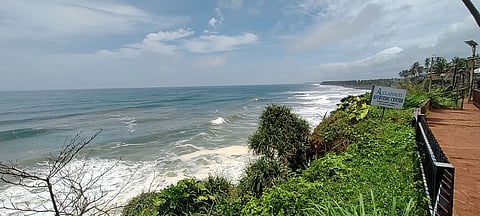

Varkala Cliff in Kerala added to UNESCO’s tentative World Heritage list
Rare Mio-Pliocene sandstone and laterite formations reveal millions of years of earth’s history
Sacred landscape with ancient Janardana Swamy temple and Sree Narayana Guru’s Sivagiri Mutt
Tourism boom brings jobs and income but also waste, erosion and unregulated building
Fisherfolk fear displacement as climate change and poor governance intensify threats
On a late monsoon morning, the sandstone cliffs of Varkala glisten under subdued light, their rust-red faces streaked with centuries of salt spray and rain. Below, the Arabian Sea churns restlessly, hurling waves at the cliff’s base before retreating. Above, coconut palms bend in the breeze, pilgrims descend barefoot to the Janardana Swamy temple beach and fishermen mend their nets for uncertain journeys ahead.
For centuries, this dramatic stretch of Kerala’s coastline has been a place where geology, faith and livelihood meet. Now, UNESCO has placed the Varkala Cliff on its tentative list of World Heritage Sites. The achievement is a global recognition of what locals have always known, this is not just scenic land, but sacred, fragile and irreplaceable.
Unlike Kerala’s otherwise flat, sandy shore, Varkala is the only place where cliffs rise directly against the sea. Locally called Sivagiri Thuruthu, the formation belongs to the Mio-Pliocene age, dating back millions of years. Its laterite and sedimentary layers hold fossils and traces of ancient climates, as an outdoor archive of earth’s evolution.
“Every band of clay, every fossil remnant tells a story,” said Meera Menon, a coastal geologist at Kerala University. “But what makes the cliff scientifically invaluable also makes it vulnerable. Laterite crumbles under pressure. Any disturbance like roads, septic tanks, drainage can destabilise the whole structure. Each collapse is irreversible.”
Erosion is already evident. Monsoons have triggered landslides and cracks; buildings teeter at the edge. Experts warned that unregulated construction and climate-driven sea surges are accelerating damage.
The cliff is also a spiritual site. The Janardana Swamy temple, over two millennia old, anchors its southern end. Pilgrims gather in their thousands on Karkidaka Vavu day to perform rituals for ancestors, transforming the beach into one of Kerala’s largest sacred spaces. Nearby stands Sivagiri Mutt, founded by social reformer Sree Narayana Guru.
“The cliff is more than land and stone; it is a witness to faith,” says temple priest Narayanan Namboothiri. Fisherfolk call it their guardian, a landmark that guides them home in storms.
Over the past three decades, Varkala has become Kerala’s backpacker alternative to Kovalam. Guesthouses, cafés and yoga centres line the cliff-top walkway. Tourism has brought money, jobs and cosmopolitan energy to what was once a sleepy coastal town.
But the boom comes at a cost. Waste spills untreated down slopes, septic tanks leak into porous soil and unauthorised buildings mushroom. During peak season, the narrow paths clog with crowds.
“Tourism saved us from poverty, but it may kill the very cliff that sustains it,” admitted Ramesh, a café owner. Activist S J Sanjeev was more blunt: “Kerala celebrates its assets while destroying them through greed. There’s no carrying-capacity study, no regulation. Profit comes first, responsibility nowhere.”
At the cliff’s base, where waves crash and nets are hauled in, worry runs deep. Fish catches have fallen, fuel prices have soared and erosion is eating into homes. Now UNESCO recognition brings fresh fears.
“They say it’s world heritage, but will we still have a place here?” asks Devaki, who sells dried fish on the beach. “Developers will come with money and push us out in the name of heritage.”
For fisherman Madhavan, the cliff once offered quiet protection. “When I was young, it was just sea and prayers. Now it is music, waste and crowds. If the cliff goes, so does our home.”
Sea-level rise, stronger monsoons and unpredictable surges threaten Kerala’s coast. In 2018 and 2019, back-to-back floods destabilised parts of Varkala’s laterite layers. “The cliff has withstood natural forces for millennia,” said Menon. “But human interference and climate change create unprecedented stress. The question isn’t if collapses will happen, but when — and how severe.”
The tourism department markets Varkala as a heritage gem, but regulation lags. Building codes are flouted, waste management is weak and coordination between geologists, planners and local bodies is poor. Proposals for a geo-park or heritage zone remain stuck in bureaucracy.
“This is classic governance failure,” said environmental historian Dr T R Ajith. “Kerala is good at branding, poor at protecting. Without strict regulation, UNESCO status could hasten destruction, not prevent it.”
Some NGOs run awareness campaigns for visitors and a few cafés practise waste segregation and eco-friendly toilets. Schools are taking students on field trips to learn geology firsthand. The state has promised a comprehensive management plan, though details are scarce.
“The cliff’s future depends on defining carrying capacity, regulating construction, involving locals and adapting to climate change,” said Sanjeev. “Anything less is tokenism.”
As the sun sets, painting the cliffs crimson and the sea gold, Varkala’s paradox is clear. It is a place where fragility itself draws pilgrims, scientists, tourists and locals. But its survival hinges on choices made now.
“The cliff holds memory, faith, livelihood and science woven together. Recognition is only the first step. What follows will decide if Varkala endures as a wonder or becomes a cautionary tale,” said Sanjeev.
The years ahead will test Kerala’s ability to balance pride with responsibility, profit with preservation. For fisherfolk, pilgrims, scientists and future generations, the cliff’s fate will determine whether humanity can live with its heritage, or consume it.